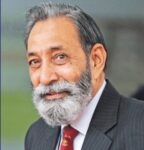Arti Jaiman
Founder, Gurgaon Ki Awaaz

The Gurgaon to Gurugram journey
A little under 10 years after the Maruti Suzuki factory was set up in the middle of the mustard fields of Gurgaon, the new urban enclaves of Gurgaon such as Palam Vihar of the Ansals and Qutab Enclave of DLF began to see its early residents move in. Alongside there were HUDA’s Sector 14 and Sector 17 which had much better facilities but did not have the spit and polish of the privately developed “colonies”. People who moved to Gurgaon in the late 80s and early 90s were pioneers who were willing to deal with scattered neighbours, very few shops for essentials and almost no connectivity to Delhi in exchange for the pleasure of owning their own home, especially a home with a garden and space all around.
In 1991, my family moved to Gurgaon, then colloquially referred to by its rustic name “Gudgaavaan”. To distinguish between this still-rural buffalo country, we told our friends and relatives in Delhi that we lived in “DLF” – that yet-to-mushroom metropolis that drew middle class Indians who couldn’t afford a home in Delhi. The distinction was important – after all, we didn’t want to sound like we’d moved into some rustic backwater (which we had, truth be told). The BPO boom was still some years away and the big-ticket employers were the auto and auto ancillary industries brought in by Maruti Suzuki.
Within a decade the city went into steroid-induced growth. By the late 1990s, the BPO sector was setting up shop, led by Genpact. Multinationals and start-ups alike found the place conducive because of the as-yet affordable rent and access for workers coming in from Delhi, as well as homes for people moving into Gurgaon.
Meanwhile, the buffaloes once plodding along MG Road had given way to zipping call centre cabs, and the wheat fields and malta orchards were being replaced at a dizzying pace by high rise apartments.
The Delhi Metro too was round the corner. When it opened in December 2004, a collective hurrah went up in our out-in-the-boonies haven as we could now get to Delhi, and to work, without resorting to hitching rides in call centre cabs or getting onto the one DTC bus that went from Gurgaon to the Safdarjung Terminal.
The Delhi Metro’s Yellow Line, connecting as it did Gurgaon to key access points such as Hauz Khas and AIIMS in South Delhi, Rajiv Chowk and Central Secretariat in Central Delhi and New Delhi Railway Station and Chandni Chowk in North Delhi, led to an exponential increase in companies and families moving to Gurgaon.
Workers from across India flocked to the factories and homes of Gurgaon to find work and a better life. In response, the local Gurgaon villagers, now landlords who had sold their fields to builders and the Haryana Government, built hundreds of thousands of tenements for these workers flocking to Gurgaon and in search of cheap housing. Basic blocks of rooms with shared toilets began mushrooming in every urban village in Gurgaon. Premium was placed on location – the closer to factories and offices or to upmarket residential areas the better – and not on facilities and build quality. Alongside, some villagers started grocery shops, some became real estate agents, and some just sat under the shade of a solitary peepul tree and watched their once sleepy forgotten mofussil town turn into “Millennium City”.
Gudgaavan also became Gurgaon. And it was totally okay now to say we lived in “Gurgaon” (we rolled the R’s to sound cool) and people who earlier didn’t visit because we were living in a “god-forsaken back of beyond” now routinely popped in as they swung by for a spot of “mall-ing” – that exercise in retail therapy that involved spending the better part of the day inside one or more of the new air-conditioned malls dotting Gurgaon’s “Mall Mile” – MG Road.
As shiny new office buildings and equally shiny malls and apartments sprung up across Gurgaon, they started over-shadowing the villages on whose lands this new Gurgaon was mushrooming. These now-urban villages were slowly sinking into a morass of over-crowded tenements filled with migrant workers from across North India; tenements that were standing cheek by jowl with shiny new houses fronted by equally shiny new SUVs and sedans owned by the local Haryanvi Gurgaon landowners.
The Haryana government was enormously proud of its urban achievement, a veritable cash-cow that has now become the single largest contributor to the state exchequer. In the media, the town-turned-city started being lauded as “Cyber City” and “Millennium City”, as the hub of MNCs and BPOs, as the city of malls, as the ‘it’ place to live and work. In the process, a gradual ‘invisiblizing’ has taken place – of the local Haryanvi-s and the culture that once defined the area and this community, as well the migrant workers, who are often treated as little more than magic elves, required to come in and do the work, but who must then magically disappear outside the golden gates of this new city into urban black holes.
An invisible wall exists between urban residents living and working in Gurgaon, and this heterogenous community of local Haryanvis and migrant workers. Many people have lived for 10 or 15 years in one of Gurgaon’s upscale condominiums but have never even stepped into the next-door villages of, say, Chakkarpur (DLF Phase 2), Sikanderpur (DLF Phase 1), Nathupur (DLF Phase 3), Wazirabad (DLF Phase 4 and 5) or Kanhai (Sector 45). Almost all support staff (security guards, cooks, maids, drivers etc.) live in these villages and yet a deep divide exists between where the employers stays and where the employee resides.
But hope also stays alive in Gurgaon. Because of some determined people not willing to let every available green space be concretized, individuals working for children deprived of even a basic education, groups working for safer roads, organisations creating those bridges between the residents and the government to save Gurgaon from the poisons of its own success.
Gurgaon, renamed Gurugram in 2016, is also the site for some of the most dramatic and successful citizen-led initiatives. Be it I Am Gurgaon that has rescued hundreds of acres of urban forests and water bodies and given them new life. The Aravali Biodiversity Park, the Chakkarpur, Wazirabad, Badshahpur and Ghata bundhs and the Sikanderpur urban forest would not have been the amazing green, inclusive spaces they are without the efforts of I Am Gurgaon. Some of the most walked roads in Gurgaon are going through a transformation because of the efforts of Raahgiri Foundation that not only advocates for inclusive and safe roads, but also designs and executes such roads to show that it is possible – to have roads that give space to pedestrians and cyclists, and thereby improve the roads for everyone.
Barring a small minority of local residents, Gurgaon is a city of migrants, from across India and across the world. A place where you can get litti chokha from Bihar outside the metro station, a nod to the thousands of migrants from Bihar who have made their home here. And you can also go into a Korean grocery store to get a special sauce, a big nod to the large Korean expat group that lives and works in the many Korean companies that manufacture and market out of Gurgaon.
Ultimately, the city is what we make it. What we allow business to make it. What we allow the government to make it. The pollution, the unsafe roads, the over-crowded urban villages are as much a part of Gurgaon as are the enormous urban forests, the large parks, the sparkling offices and malls. Each are a mirror to what we as citizens are willing to tolerate or collectively work towards. In that sense, this city is us.
Related Expert Opinion

Shikha Gupta
Director, Kalagram
Gurgaon as a Cultural City
Gurgaon is a city of diverse cultures, values, and tastes. And for any city art and culture serve as the sole thread capable of connecting every citizen together transcending cultural or societal differences. […]
Col. Kr. Pratap Singh
Chairman, JAFRA
Not a Smart City: Gurgaon
Gurgaon is a cosmopolitan millennium city on the world map. Beautiful builder societies and condominiums are either present or coming-up in Gurgaon. The night life, shopping and glitter surpasses New York and Singapore in looks. […]

Brig. S K Sharma
Architect and Urban Planner
